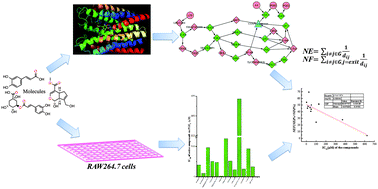Insights into the inhibition and mechanism of compounds against LPS-induced PGE2 production: a pathway network-based approach and molecular dynamics simulations†
Abstract
In comparison to the current target-based screening approach, it is increasingly evident that active lead compounds based on disease-related phenotypes are more likely to be translated to clinical trials during drug development. That is, because human diseases are in essence the outcome of the abnormal function of multiple genes, especially in complex diseases. Therefore, as a conventional technology in the early phase of active lead compound discovery, computational methods that can connect molecular interactions and disease-related phenotypes to evaluate the efficacy of compounds are in urgently required. In this work, a computational approach that integrates molecular docking and pathway network analysis (network efficiency and network flux) was developed to evaluate the efficacy of a compound against LPS-induced Prostaglandin E2(PGE2) production. The predicted results were then validated in vitro, and a correlation with the experimental results was analyzed using linear regression. In addition, molecular dynamics (MD) simulations were performed to explore the molecular mechanism of the most potent compounds. There were 12 hits out of 28 predicted ingredients separated from Reduning injection (RDN). The predicted results have a good agreement with the experimental inhibitory potency (IC50) (correlation coefficient = 0.80). The most potent compounds could target several proteins to regulate the pathway network. This might partly interpret the molecular mechanism of RDN on fever. Meanwhile, the good correlation of the computational model with the wet experimental results might bridge the gap between molecule–target interactions and phenotypic response, especially for multi-target compounds. Therefore, it would be helpful for active lead compound discovery, the understanding of the multiple targets and synergic essence of traditional Chinese medicine (TCM).


 Please wait while we load your content...
Please wait while we load your content...